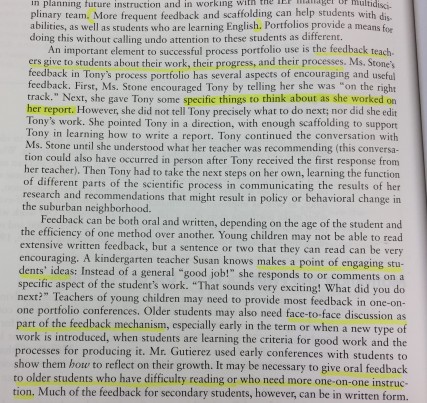6.4 Using Assessment to Provide Feedback to Students – teacher’s feedback to students is timely and of consistently high quality. To me, 6.4 will require a teacher’s ability to pinpoint students’ strengths and identify areas for improvement in a positive manner that doesn’t negatively affect their student’s ego. High-quality feedback should reflect a growth mindset rather than an ego mindset where students question their ability or effort, which can be ineffective to their learning. Feedback should push student thinking forward rather than cause an emotional reaction. With a growth mindset in mind, I follow Taylor & Nole

Figure 1
n (2008) suggestion of using portfolios as a means to provide timely and effective feedback. Portfolios allow teachers to see how much their students have learned over a period of time because the student’s work is only being compared to their former abilities. Figure 1 shows an example of effective teacher feedback dialogue as well as a rationale for giving feedback in both oral and written format for process portfolios. Ms. Stone illustrated encouraging and effective feedback with Tony by directing her towards specific things to think about rather than just editing the report without explanation. The feedback was effective because the teacher held a continuous conversation with Tony throughout her process portfolio which limits any misconceptions on the assignment and gave her timely support on how to write a report. Presenting feedback in a timely manner that allows student reflection and revision is important because otherwise the students will have moved on with either faulty understanding or feel that the teachers don’t value their effort. This evidence illustrates how continuous feedback over a course of a student’s portfolio can result in increased mastery of subject as well as motivation when they see how much they have improved. It’s important to use feedback as a way to engage student’s ideas and help them reflect on their growth throughout the process portfolio. This evidence also taught me that portfolios provide more help to students with disabilities or students who are struggling with English because it allows for more frequent feedback and scaffolding. To increase the effectiveness of process portfolios, I would require students to include peer edit drafts of their work as well as evidence that they listened to their peers’ feedback, which the teacher would then comment on. Process portfolios would then be an excellent addition to parent conference meetings because it illustrates students’ individual growth as well as the teacher’s commitment towards their student’s learning goals.
